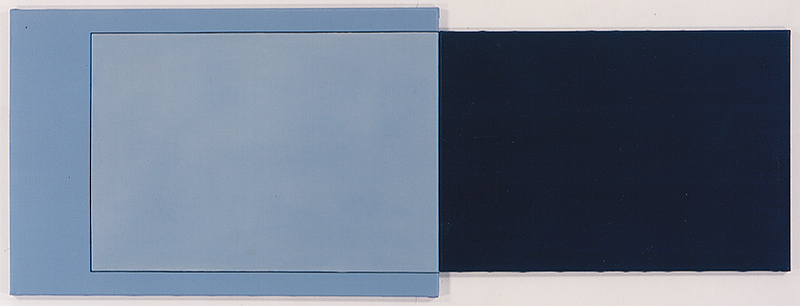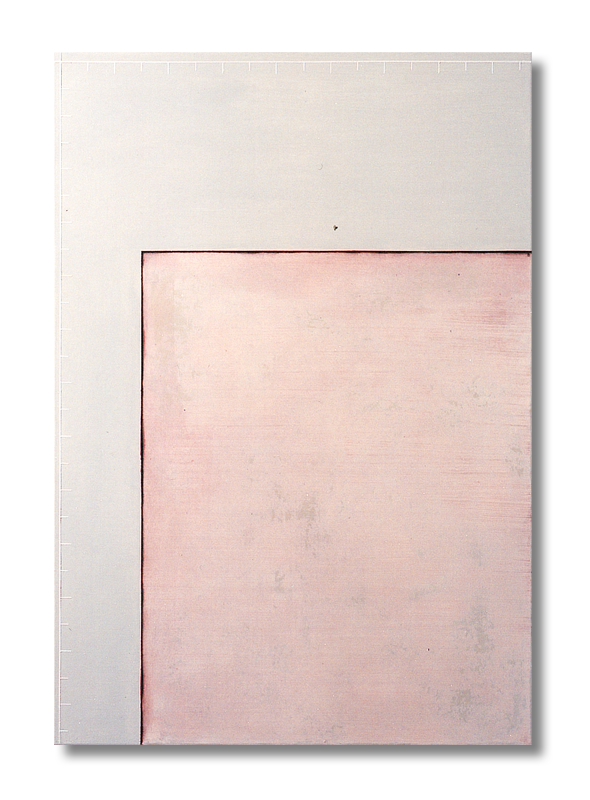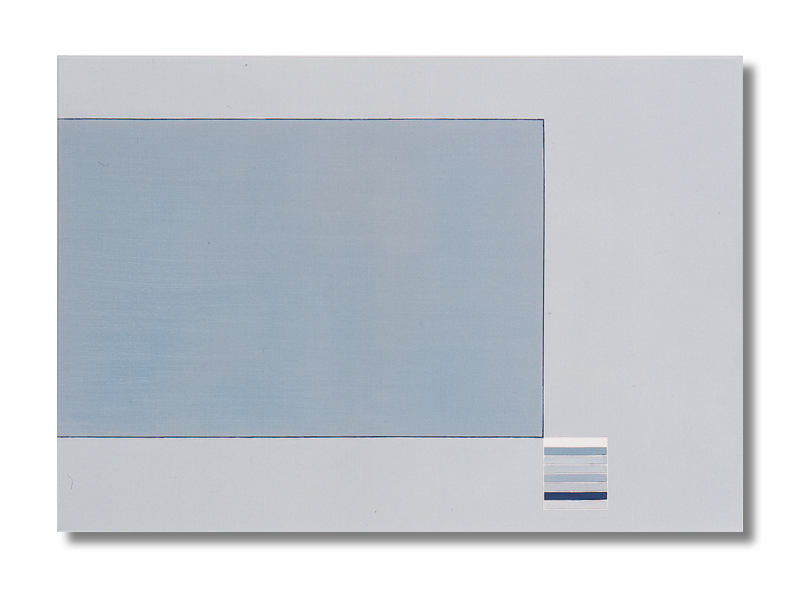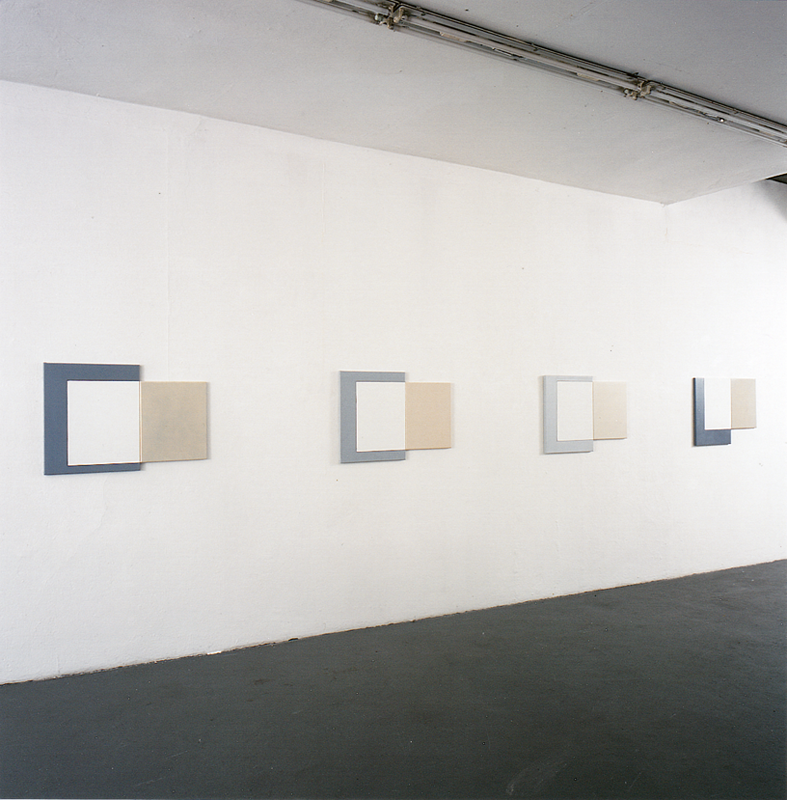2004 Katerina Vatsella
Katerina Vatsella // Between intellect and feeling - Sabine Straßburger's pictures
A shining blue rectangle seems to have pushed straight to the right out of the dark blue and somewhat wider left section of the picture made up of two canvasses. The title is „No. 20 [French Seascape]“ (p.12). Its bright matching piece (p. 13) is a bit less dynamic but just as intensive: Here a dark rectangle has protruded from the left side of the picture and now hovers quietly but at the same time dynamically on the wall. Its outline is still recognizable as a lighter area in the painting’s left half. On the other hand, dark green determines the inner surface of a horizontal format painting, which is restricted by a cool, light green edge, titled „No. 1 00 [French Landscape]“ (p. 15).

No. 20 [french marine] 2003 60x163cm, 2-parts oil, pigment/canvas
Pushed down to the left, the inner dark green rectangle has a similar tension as is noticeable in the blue paintings just mentioned — potentially, it could start to move at any time and slide out of the picture. Turning to look at another piece of work. this time an upright format (p. 9), one finds a similarly severe division of the picture space: A rectangle within a rectangle, pushed slightly downwards to the right, the outer rectangle light grey, the inner one kept in a yellowish glimmering pale pink:“No. 30 [French Portrait]“.

No. 30 [french portrait] 2002 130x90cm oil/canvas
The titles of these abstract, strictly geometrically designed paintings are surprising, particularly because none of them has a concrete or figurative relation to the themes of marine, landscape or portrait. How are they to be understood?
When researching into norms, relations and proportions in art, Sabine Straßburger noticed that not only the contents of pictures but also the picture formats follow certain basic rules and standardizations. Since the 19th century in France, for instance, standard formats are in use for certain themes: Always different ones for „seascape“, „landscape“ and „portrait“.
Their different sizes are just as standardized: No. 20, no. 30 or no. 100, etc. Sabine Straßburger took over these historical formats and put them onto her canvasses as drawn-in rectangles. Different colour qualities underline the difference of the formats and a stylized ruler often appearing at the pictures edges points to the different measurements,
„Painting is my way of thinking“, says Sabine Straf3burger But it is no thinking that communicates through language, that expresses itself by words and sentences. lt is an observing and reflective and at the same time feeling and sensitive thinking which Sabine Straßburger translates into colours and forms and which she examines in many variations of impressive, austere beauty
From the very beginning, she follows two strands in her work: On the one hand, she continually analyzes and inspects her own pictorial means: She explores the material quality and optical effect of the colour its contrast and tonality — whether light or dark. pure or mixed — or the structure and quality ofthe paint’s application — whether glazed, transparent or syrupy, covering. But she is also concerned with the format of the pictures and the relation of the height and width of their outer measurements, of the inner surface and edge, of depth and surface.
On the other hand, she is occupied with the development of a pictorial language in a lexical-etymological or a semantic sense: In this endeavour she is concerned with the meaning of colourfulness and signs, with terms and facts for which she has, in the course of time, created a type of picture code or geometric-abstract vocabulary consisting of lines, crosses, brackets, circle segments, dots and other signs marking, defining or limiting surfaces or spaces also outside the artistic context. These signs include rectangular stripes of colour of varying size which occasionally appear in her paintings. They look like colour charts ard document the layers of paint put one on top of the other by Sabine Straßburger in order to build up her intensive colour planes. lt follows that they contain not only a technical and explanatory aspect but also a time dimension of the paint application process. Sometimes the deeper lying colour tones shine through and lend to her paintings very individual colour hues.

No. 40 [french marine] 2005 100x135cm oil/canvas
Sabine Straßburger likes to work in series in which she examines a theme in a number of variations. Time and again she always differently combines identical or similar picture elements in various colour tones, re-phrases them, specifies their relations. With this consistent analytical way to analyze, Sabine Straßburger approaches the principles of minimal art in which the conciseness of visual perception is a core concern. Or one might say that she comes dose to geometric abstraction which, amongst other issues, makes the interaction of the picture constitutive elements of its subject — evoking echoes of and analogies with the works of artists such as Robert Ryman, Robert Mangold or some time later Imi Knoebel.
She herself also feels dose to Mark Rothko. This closeness felt by her speaks for the sentimental side of her work and for the central role of colour in her work beyond the geometric construction. lt is moods, the atmosphere of places, of occurrences, of people which Sabine Straßburger captures in her abstract pictures. Often she combines reminiscences with colour and colour tones. Sometimes her inspiration is suggested by the picture title: Then a series of four two-part pictures in related colours, but nevertheless of very different character is entitled Family Portraits No. 8 [French Portraits]“ (p. 20).

1st series of portraits of the family [french portait no.8] 2002 4x60x88cm, 8-parts oil, pigment/canvas
To sum it up: The flowing, unconstrained combination of consistent conceptual method with intuitive design is characteristic of Sabine Straßburger’s paintings and lends them depth and substance beyond the merely aesthetic.
Katerina Vatsella
(Translation: Joan Leisewitz)